The Frame/Exposure Counter
 |
|
With the exception of frame number one, every even number is represented by a numeral. Even the frame counter counts up to 36 exposures in numbers, the film can still be advanced. At the end of each roll, resistance will be felt when you attempt to advance further, and you should rewind the film then.
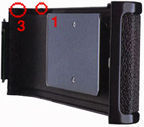 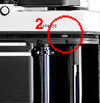 |
Wondering how the counter reset when the camera back is opened ? May be I could explain to you what is the mysterious pin (2) hiding at the film back rail are made for. Open your camera back and you will notice at the top of the film back are not straight (Newer designs are not obvious, only a slight contoured outline was moulded closer to the film back release latch (3)). |
When the film back is closed, the edge will trigger the pin on the camera body and activate the mechanism of the frame counter. When the film back is opened and cause the connection broke off, it will activate and reset another mechansim to reset the counter to be pre-frame position.This mechanism is full mechanical. Almost all cameras use this theory.. errr. I have the check the lastest F5 first, ha!
Film Advance Lever
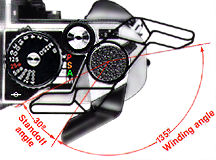 |
To advance the film, wind the lever to the right completely until it stops The lever returns to the standoff position as soon as you take your thumb off the lever. A single complete stroke advances the film one frame and simultaneously cocks the shutter. |
The film advance lever in the FA wasn't designed as with the F series camera models, where it cannot use multiple of short strokes to complete a full stroke. When it is flush with the camera body, it acts as a safety lock (You cannot trip the shutter release then). When the film advance lever is at the 30° "stand-off" angle, the camera's electronics will activate. Just depress half way on the shutter release button will also turns the metering on.
Unloading the Film
When the film reaches the end of the roll, the film advance lever cannot be wound
any further. Don't apply any force then. Check the counter and see if it has reaches
'around' theoretical limit of the film in use. Or sometimes, you need to rewind the
film in mid-roll in situations like changing a another film with different film speed
etc., for whatever the reasons, you need to rewind and unload the film, just follow
the procedures here:
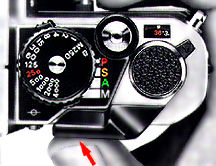 |
1. Push the film advance lever back into place to turn off the camera and lock the shutter release button. This action prevents inadvertent shutter release and save some battery power... |
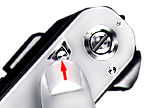 |
2. Depress the rewind button that locates on the bottom of the camera. You don't have to apply continuous pressure to the button: just press it once that will do. |
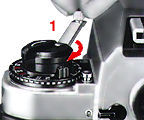 |
|
4. Open the camera back and take
out film cartridge by pushing the safety lock and pull up the rewind knob (Refer
back to loading sequence). Avoid unloading in direct sunlight. If there is no shade
available, turn your back to the sun and use your own shadow to shield the camera.
It is not advisable to keep the film leader out - unless with a purpose. This is
especially true when you are working with high volume assignments. It could be easily
mix up with the unexposed rolls. In some situations where you need to reload a partially
exposed roll for shooting like possible situation we explained earlier (Set the correct
film speed again), set the shutter speed dial to 1/4000 sec, turn the aperture value
to the minimum (f16, f22 or f32), put the lens cap back on with your hand to shield
it, turn on the eyepiece shutter blind, if possible do it in a dark environment and
then reload the film. You need to go back to the original frame number and buy some
insurance by add or wasting few blank shots extra to avoid overlapping of expsoures.
Warning: NEVER attempt this method if you are new to this,
it needs some good experience to handle this task.
Memo Holder Unless you have bought a used FA with a
databack attached, the normal film back has a memo holder behind the film back. The
Nikon FA has no automatic DX coding to do auto film speed recognition (If I can still
recall, the F301 is, huh ?). You can tear out the side of the film box, and insert
a film box end in the memo holder to remind you of the type of film in use. Or you
take take down the photodata and store it here manually. Newer AF camera models has
removed this feature from the spec sheet, but it comes in very handy for seasoners.
The first three parts complete the setup for the FA. We will start off with the preparation
of the camera for exposures.
| Back | Next | 3/13
parts
|
Back | to Main Index Page of Nikon
FA
Other Technical
Issues
Relating to Nikon FA
Camera Instruction
Manual - HTML | PDF
(1.4 MB)
Main Reference
Map for Body -
HTML | PDF
(731k)
Specifications - HTML
| PDF (245k)
The AI-S Nikkors (related info | TTL OTF Flash Metering | Interchangeable Focusing Screens. The MD-15/MD12/MD11 Motor Drives | 3rd party Power Winder (new) | Flash Units - | SB-15 | SB-10 | SB-16B & Other Options | Databacks | Titanium Shutter | Variation : Mr Y K Wong from Singapore contributing 11 images of his Nikon FA GOLD
| Nikon FM series |
Nikon FE series |
Nikon
FA |
W A R N I N G: The New G-SERIES Nikkor lenses have no aperture ring on the lens, they CANNOT ADJUST APERTURES with any of these manual focus Nikon FE series SLR camera models; please ignore some portion of the content contained herein this site where it relates.
| Message Board | for your favourite Nikon FA camera
| Message Board | for your Nikon Optics in a shared environment
| Message Board | Specifically for Dispose or Looking for Nikon / Nikkor Photographic Equipment
Shared Resources: MD-11 | MD-12 | 3rd Party Power Winder Only for FM2(n)/FE2/FA | Focusing Screens | Titanium Shutter | Flash Units - | SB-15 | SB-10 | SB-16B & Other Options | Databack | Nikkor lens mount (related info)
Others:- Nikon AF-TTL Speedlights | SB-20 (1986) | SB-22 (1987) | SB-23 | SB-24 (1988) | SB-25 (1991/2) | SB-26 (1994) | SB-27(1997) | SB-28 (1997) | Nikon SB-29(s) (2000) | Nikon SB-30 (2003) | Nikon SB-600 (2004) | Nikon SB-800 (2003) Nikon AF-TTL Speedlight DX-Series: Nikon SB-28DX (1999) | SB-50DX (2001) | SB-80DX (2002)
Nikon
BC-flash Series |
Original
Nikon Speedlight
SB-2
| SB-3 | SB-4
| SB-5
| SB-6 | SB-7E
| SB-8E
| SB-9 | SB-E
| SB-10
SB-11
| SB-12 | SB-14 | SB-140 UV-IR| SB-15 | SB16A | SB-17 | SB-18, SB-19 | SB-21A (SB-29) Macro flash | Flash Accesories | SF-1
Pilot Lamp
| Nikon F | Nikon F2 | Nikon F3 | Nikon F4 | Nikon F5 | Nikon F6 | Nikkormat / Nikomat | Nikon FM | Nikon FE/ FA | Nikon EM/FG/FG20 | Nikon Digital SLRs | Nikon - Other models |
Nikon Auto Focus Nikkor lenses:- Main
Index Page
Nikon Manual Focus Nikkor lenses:- Fisheye-Nikkor Lenses - Circular | Full Frame |
Ultrawides Lenses - 13mm15mm18mm20mm | Wideangle Lenses - 24mm28mm35mm | Standard Lenses - 45mm 50mm 58mm | Telephoto
Lenses - 85mm105mm135mm180mm & 200mm | Super-Telephoto Lenses - 300mm 400mm 500mm 600mm 800mm 1200mm |
 Index Page |
Special
Application lenses: Micro-Nikkor Lenses - 50mm~55mm -60mm 85mm -105mm 200mm Micro-Zoom 70-180mm Perspective Control (PC) - 28mm 35mm PC-Micro 85mm Dedicated Lenses for Nikon F3AF: AF 80mm f/2.8 | AF 200mm f/3.5 EDIF Depth of Field Control (DC): 105mm 135mm Medical Nikkor: 120mm 200mm Reflex-Nikkor Lenses - 500mm 1000mm 2000mm Others: Noct Nikkor | OP-Nikkor | UV Nikkor 55mm 105mm | Focusing Units | Bellows-Nikkor 105mm 135mm Nikon Series E Lenses: 28mm35mm50mm100mm135mm | E-Series Zoom lenses: 36~72mm75~150mm70~210mm |
MF Zoom-Nikkor Lenses: 25~50mm | 28~45mm | 28~50mm | 28~85mm | 35~70mm | 36~72mm E | 35~85mm | 35~105mm | 35~135mm | 35~200mm | 43~86mm | 50~135mm | 50~300mm | 70~210mm E | 75~150mm E | 80~200mm | 85~250mm | 100~300mm | 180~600mm | 200~400mm | 200~600mm | 360~1200mm | 1200~1700mm
Tele-Converters: TC-1 | TC-2 | TC-200 | TC-201 | TC-300 | TC-301 | TC-14 | TC-14A | TC-14B | TC-14C | TC-14E | TC-16 | TC-16A | TC-20E
Recommended links to understand more technical details
related to the Nikkor F-mount and production Serial Number:
http://rick_oleson.tripod.com/index-153.html by: my
friend, Rick Oleson
http://www.zi.ku.dk/personal/lhhansen/photo/fmount.htm by: Hansen,
Lars Holst
http://www.mir.com.my/rb/photography/hardwares/nikonfmount/lens2.htm
http://www.photosynthesis.co.nz/nikon/serialno.html
|
Back | Main Index Page of Nikkor Resources
|
Back | Main Index Page of Pictorial
History of Nikon SLRs
| Message Board | for your Nikkor optics ("shared" because I do wish some of you to expose to other's perspective as well. Isn't it a sad sate to see photography has to be segmented into different camps from the use of various labels)
about this photographic web site
Home - Photography in Malaysia |
A contributing effort to Michael C Liu's Classic Nikon Site.
Credit: Chuck Hester for some of his beautiful images used in this site; Ted Wengelaar®, Holland for his continuous flow of input; Lars Holst Hansen, Danish 'Hawkeye' who shares the same passion; Mr Poon from Poon photo for their input; Ms Miss Rissa (Sales Manager) & members of the Technical Service dept. of Shriro Malaysia, local distributor of Nikon cameras in Malaysia & Singapore, in providing so many useful input to make this site possible. Special thanks to Mr MC Lau, who has helped with his images of the MF-12 databack. Michael Tan, Pertama Photo (603-2926505) for lending his original Titanium Shutter Display Unit. Dave Hoyt who has prepared the introductory page and offer some images of his FE2 in this site.. Hiura Shinsaku, Nikomat ML, Japan for his contribution on all the various images; A contributing site to a long lost friend on the Net. Note: Certain content and images appeared in this site were either scanned from official marketing leaflets, brochures published by Nikon and/or contribution from surfers who claimed originality of their own work to publish in this site based on educational merits. The creator of this site will not be responsible for any discrepancies that may arise from such possible dispute except rectifying them after verification."Nikon", "Nikkormat", "Nippon Kokagu KK" & "Nikkor" are registered tradename of Nikon Corporation Inc., Japan. Made witha PowerMac.
 The additive type
frame counter is graduated from S, two dots, 1, 2, 4 - up to 36 in even numbers with
odd numbers indicated by white dots in between. The frame counter advances a single
frame by one complete stroke of the film advance lever. After reaching frame 36 of
a 36 exposure roll of film, the counter will not operate. however, film will be advanced
until the actual end of the film roll. The frame counter automatically resets to
S when the camera back is opened. In multiple exposure mode, the frame counter does
not advance when the multiple exposure lever has been activated.
The additive type
frame counter is graduated from S, two dots, 1, 2, 4 - up to 36 in even numbers with
odd numbers indicated by white dots in between. The frame counter advances a single
frame by one complete stroke of the film advance lever. After reaching frame 36 of
a 36 exposure roll of film, the counter will not operate. however, film will be advanced
until the actual end of the film roll. The frame counter automatically resets to
S when the camera back is opened. In multiple exposure mode, the frame counter does
not advance when the multiple exposure lever has been activated.